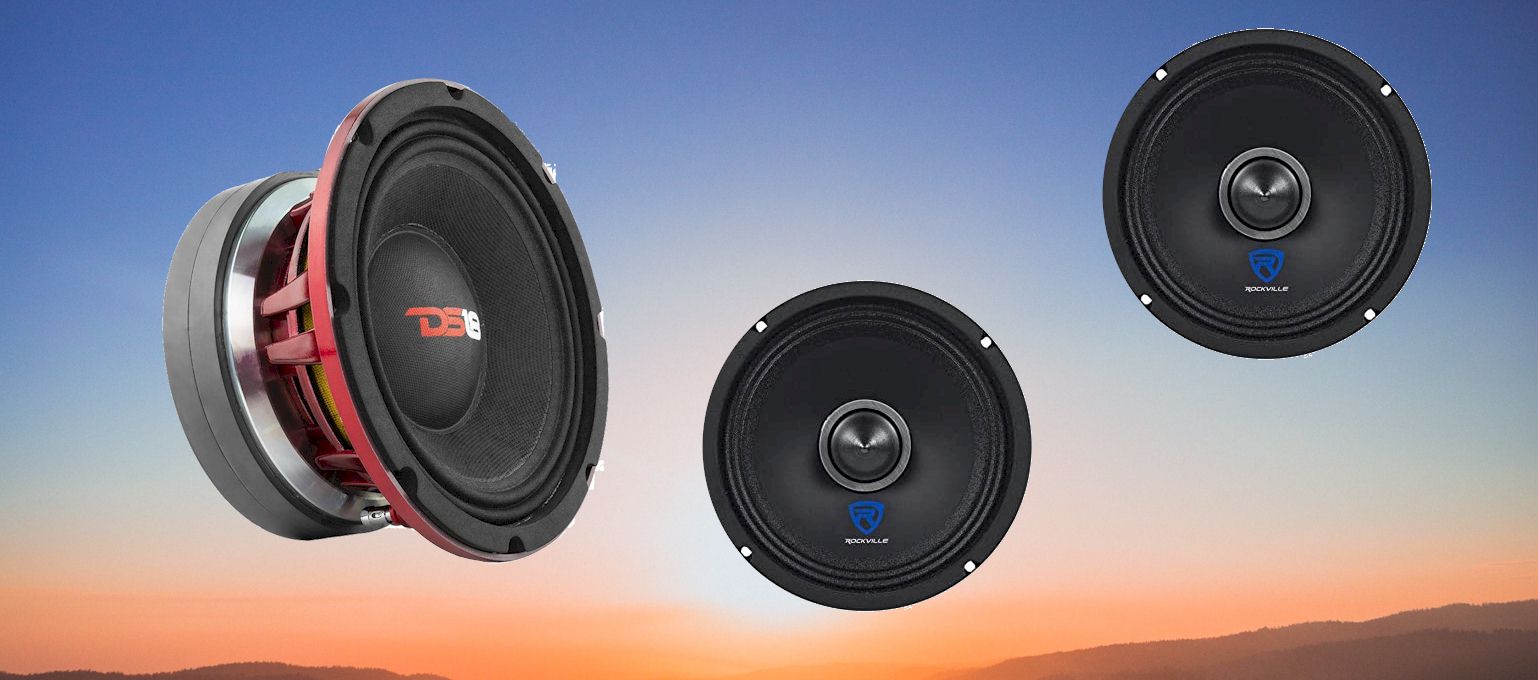Driving in a car that sends the interior of your car into deep vibration from the intensity of high-quality sound waves in the form of music is a dream come true for audiophiles.
For audiophiles, choosing between Midrange and Mid-bass might not necessarily be a tough decision for you. But with curious audiophile newbies, the Midbass vs. Midrange difference might seem unclear and pretty confusing.
Hence, it complicates the car stereo buying process for beginner audiophiles. They usually are not sure of which type of car stereo delivers the result they want to see.
Keep reading to discover what both terms mean and which stereo type you need to elevate the sound experience in your car.
Contents
Midbass vs. Midrange; The Differences among them
Aside from the prefixes "Mid" that sits in front of the words "Midrange" and "Midbass,” and a host of other similarities like in their appearance, these two speakers, or drive, types share quite a few differences. We’ll address the differences so you’ll make a better-informed decision.
The first seemingly noticeable difference between Midrange and Midbass speakers is their size. Generally, Midbass speakers are taller than Midrange speakers. While you'll see a Midrange speaker that is 4-inches in height, Midbass speakers are about 8-inches.
But these sizes are not static for these speakers as it varies depending on the brand. The sizes of these speakers seem to influence the level of frequency or sound that they can produce.
For instance, a 4-inch Midrange speaker would produce high-pitch sounds. However, suppose you are particular about the quality of the human vocals and the details it delivers in a song. In that case, you'll hear it better with a Midrange speaker installed in your vehicle.
On the other hand, Midbass speakers are 8-inches in size. But that's the average size of Midbass speakers. You'll get speakers that are higher than 8-inches in size. Regardless of the size, all Midbass speakers share one thing in common; they boost your music experience.
The frequency response of both speakers is another feature that differentiates them. A Midrange speaker and a Midbass do not and cannot function on the same frequency. Generally, they both produce different sounds on different levels.
For starters, Midbass speakers produce sounds within the low-frequency scale. Hence, you'll expect to get a frequency response of 80 Hz to 350 Hz—the Midrange speaker functions within the middle-frequency scale with the frequency of 350 Hz to 5 kHz. As a result, Midrange speakers tend to produce flat sounds.
You can achieve crisp sounds with a Midrange speaker, but you have to connect it to a subwoofer to get high-quality, crispy sounds that you'll enjoy in your car.
Pairing your Midrange speaker with a subwoofer isn't the problem if you already have a subwoofer and the Midrange speaker. If you'll have to buy both, that's where the Midbass speaker comes in.
You can easily swap the need of buying a subwoofer and a Midrange speaker with a single Midbass speaker. You'll get an overall fantastic music experience.
The sound quality from both speakers is another remarkable difference between Midrange and Midbass speakers. From its name, you can already figure out that Midbass speakers produce low-frequency sounds. But they are an excellent choice for improving the sound quality you get from your sound system.
It adds more details to the overall sound. Midrange speakers, on the other hand, flat produce sounds. Since it is a Midrange speaker, it doesn’t produce high or low sounds. Hence, to get any real quality from this speaker, you’ll need a subwoofer.
RELATED: How to install tweeter in your car
What is a Midbass?
Audiophiles understand that there are certain levels to bass sounds. While audio systems can produce specific depths of bass, the Midbass refers to a bass type of high frequency.
It’s not a driver, but a frequency that produces bass sound frequency from 80Hz to lower than that. Most people refer to Midbass systems as mid subwoofers. Suppose you're passionate about getting all the details from sounds and do not mind spending the extra money to build yourself a complete and detailed sound system. In that case, the Midbass speaker is usually added to the subwoofer to produce exact low frequencies.
However, if you do not have the cash to spare, a subwoofer or midrange speaker can produce something similar to the Midbass speaker. Most people who add Midbass speaker to their sound system often argue that it makes all the difference in sound.
However, there might not be much difference without it in reality, based on those who do not recognize the Midbass speaker. Regardless of what people think, there are advantages to adding a Midbass speaker to your sound system.
For starters, you'll enjoy the smooth transition of your sound system from sub-bass or deep bass to Midbass. Generally, this means you get to hear every bass sound detail in any song you listen to you. Truthfully, that could broaden how you see music and sharpen your music taste.
Midbass speakers are fantastic when listening to slow songs. While you might enjoy listening to slow songs on high pitch speakers, you’ll have an exceptional music experience.
Although audiophiles argue that you can get that experience when combining a subwoofer and a Midrange speaker, it is only plausible if you already have a subwoofer and a Midrange speaker.
However, if you do not have a Midrange speaker or a subwoofer, you can always explore the Midbass option. The reason is that it is cost-effective to spend on a single Midbass system than on two speakers- subwoofer and midrange.
Furthermore, if you love to hear music sound organized or flow in a single direction, a Midbass speaker does this work better than multiple range speakers. They seem to sound all over the place.
Multiple range speakers always seem to produce sound with too many distortions. But with a Midbass speaker, especially when you pair it with a mono-woofer, you'd hear a significant boost in the music's sound quality and direction.
Related: How to connect a subwoofer to an old amplifier
What is a Midrange?
When you think about Midrange speakers, think in terms of the frequency range they produce. It’s usually between 250Hz to 5kHz. But the frequency response of these Midrange speakers varies. While some midrange speakers offer 35oHz to 5kH, others offer 250Hz to 5000khz.
Nevertheless, these frequency responses are usually found amongst midrange speakers. In reality, the lowest part of a midrange speaker is where a Midbass stops. The frequencies it produces are always higher compared to a Midbass speaker.
Most people think of investing in a Midrange speaker when they need to boost the sound quality from their Mid woofers and tweeters. It's a great way to boost the frequencies exchanged between tweeter and Mid woofers.
To be more precise, midrange speakers are ideal for you if you're not a fan of deep, vibrating music that leaves your heart pounding. If you love the opera, aurora, and other music genres that utilize the element of the soft human voice and soft, peaceful music, a great Midrange speaker is good.
However, because the frequency range of midrange speakers varies, you have to be careful when choosing the right midrange speaker for your music appetite. It is worthy of note that midrange speakers would do a terrible job producing high-end and low-end frequencies.
They are wired for midrange sounds. You'd be disappointed if you expect midrange speakers to produce high or shallow bass notes. Hence, it’s not far-fetched that you most likely won’t get crisp sound from a midrange speaker.
But you can always use a woofer to improve the sound quality of a midrange speaker. Generally, audiophiles do not only invest in midrange speakers alone. They purchase midrange speakers alongside tweeter or subwoofers for better sound quality and better music transition.
But audiophiles never purchase midrange speakers as standalone speakers as their sound quality is flat. Hence, the best use of midrange speakers is as bridge speakers that allow for seamless transitions. Just know that a midrange speaker in your sound system means better sound dispersion for you.
Related: How to Fix a Blown Car Speaker
Verdict
In this musically inclined era with many songs and artists to explore, almost everyone with a car can't afford to go on a journey without their favorite music or a great song blast through the speakers. Music has become a significant part of people's existence.
But you won't get the complete details from your favorite song without a solid sound system in place. Now, you could settle with the factory speakers that came with your car if you’re not big on sound details. But true audiophiles are never truly satisfied.
Hence, they set out to build their car audio system that'll satisfy their music appetite. In the process of building your car's audio system, you'd get stuck as regards which speaker to add to your audio system further to boost the sound quality of your sound system.
In that time, we believe that our Midbass vs. Midrange comparison feeds you with the required knowledge to make the best decision for your car’s audio system. Enjoy.

HI, John Andrew here. I’ve been an audiophile since I was a little kid. I’m an original member of myaudiolover . It emerged as a way for me to share my passion and knowledge for audio technology. If you’re looking for tips, techniques, and insights about audio-tech, that can enable your productions that professional edge, then MyAudioLover is the place for you!


Thanks for sharing this complete guide
Yes thank you very much for the complete break down I really appreciate it.
Can I run a midrange and midbass in each front door to accompany subwoofers in the rear and tweeters in the A pillar? All high quality with proper amps to feed a little above rms? I have completed my high amp alternator upgrade and big 3. My goal is to hear each and every note.